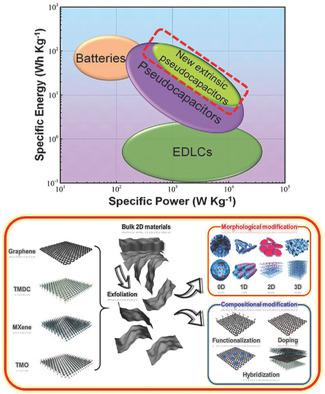当前位置:
X-MOL 学术
›
Adv. Energy Mater.
›
论文详情
Our official English website, www.x-mol.net, welcomes your
feedback! (Note: you will need to create a separate account there.)
Emergent Pseudocapacitance of 2D Nanomaterials
Advanced Energy Materials ( IF 24.4 ) Pub Date : 2018-02-05 , DOI: 10.1002/aenm.201702930 Xu Yu 1, 2 , Sol Yun 1 , Jeong Seok Yeon 1 , Pallab Bhattacharya 1 , Libin Wang 3 , Seung Woo Lee 4 , Xianluo Hu 3 , Ho Seok Park 1, 5
Advanced Energy Materials ( IF 24.4 ) Pub Date : 2018-02-05 , DOI: 10.1002/aenm.201702930 Xu Yu 1, 2 , Sol Yun 1 , Jeong Seok Yeon 1 , Pallab Bhattacharya 1 , Libin Wang 3 , Seung Woo Lee 4 , Xianluo Hu 3 , Ho Seok Park 1, 5
Affiliation

|
Two dimensional (2D) nanomaterials are very attractive due to their unique structural and surface features for energy storage applications. Motivated by the recent pioneering works demonstrating “the emergent pseudocapacitance of 2D nanomaterials,” the energy storage and nanoscience communities could revisit bulk layered materials though state‐of‐the‐art nanotechnology such as nanostructuring, nanoarchitecturing, and compositional control. However, no review has focused on the fundamentals, recent progress, and outlook on this new mechanism of 2D nanomaterials yet. In this study, the key aspects of emergent pseudocapacitors based on 2D nanomaterials are comprehensively reviewed, which covers the history, classification, thermodynamic and kinetic aspects, electrochemical characteristics, and design guidelines of materials for extrinsically surface redox and intercalation pseudocapacitors. The structural and compositional controls of graphene and other carbon nanosheets, transition metal oxides and hydroxides, transition metal dichalcogenides, and metal carbide/nitride on both microscopic and macroscopic levels will be particularly addressed, emphasizing the important results published since 2010. Finally, perspectives on the current impediments and future directions of this field are offered. Unlimited combinations and modifications of 2D nanomaterials can provide a rational strategy to overcome intrinsic limitations of existing materials, offering a new‐generation energy storage materials toward a high and new position in the Ragone plot.
中文翻译:

二维纳米材料的紧急伪电容
二维(2D)纳米材料由于其独特的结构和表面特性而在储能应用中非常具有吸引力。受最近展示“ 2D纳米材料的准伪电容”的开创性工作的激励,能量存储和纳米科学界可以通过最先进的纳米技术(例如纳米结构,纳米结构和成分控制)来重新研究块状层状材料。但是,目前尚无关于这种2D纳米材料新机制的基本原理,最新进展和前景的评论。在这项研究中,全面综述了基于二维纳米材料的新兴伪电容器的关键方面,涵盖了历史,分类,热力学和动力学方面,电化学特性,外部表面氧化还原和嵌入伪电容器的材料设计指南。石墨烯和其他碳纳米片,过渡金属氧化物和氢氧化物,过渡金属二硫化碳和金属碳化物/氮化物在微观和宏观上的结构和组成控制都将得到特别关注,强调了自2010年以来发表的重要成果。提供了该领域的当前障碍和未来方向。二维纳米材料的无限组合和修改可以提供一种合理的策略,以克服现有材料的固有局限性,从而向Ragone图中的高新位置提供新一代储能材料。石墨烯和其他碳纳米片,过渡金属氧化物和氢氧化物,过渡金属二硫化碳和金属碳化物/氮化物在微观和宏观上的结构和组成控制都将得到特别关注,强调了自2010年以来发表的重要成果。提供了该领域的当前障碍和未来方向。二维纳米材料的无限组合和修改可以提供一种合理的策略,以克服现有材料的固有局限性,从而向Ragone图中的高新位置提供新一代储能材料。石墨烯和其他碳纳米片,过渡金属氧化物和氢氧化物,过渡金属二卤化物和金属碳化物/氮化物在微观和宏观水平上的结构和组成控制都将得到特别关注,强调了自2010年以来发表的重要成果。提供了该领域的当前障碍和未来方向。二维纳米材料的无限组合和修改可以提供一种合理的策略,以克服现有材料的固有局限性,从而向Ragone图中的高新位置提供新一代储能材料。特别是从微观和宏观两个层面对金属碳化物/氮化物进行了研究,强调了自2010年以来发表的重要成果。最后,提供了对该领域目前的障碍和未来方向的看法。二维纳米材料的无限组合和修改可以提供一种合理的策略,以克服现有材料的固有局限性,从而向Ragone图中的高新位置提供新一代储能材料。特别是从微观和宏观两个层面对金属碳化物/氮化物进行了研究,强调了自2010年以来发表的重要成果。最后,提供了对该领域目前的障碍和未来方向的看法。二维纳米材料的无限组合和修改可以提供一种合理的策略,以克服现有材料的固有局限性,从而向Ragone图中的高新位置提供新一代储能材料。
更新日期:2018-02-05
中文翻译:

二维纳米材料的紧急伪电容
二维(2D)纳米材料由于其独特的结构和表面特性而在储能应用中非常具有吸引力。受最近展示“ 2D纳米材料的准伪电容”的开创性工作的激励,能量存储和纳米科学界可以通过最先进的纳米技术(例如纳米结构,纳米结构和成分控制)来重新研究块状层状材料。但是,目前尚无关于这种2D纳米材料新机制的基本原理,最新进展和前景的评论。在这项研究中,全面综述了基于二维纳米材料的新兴伪电容器的关键方面,涵盖了历史,分类,热力学和动力学方面,电化学特性,外部表面氧化还原和嵌入伪电容器的材料设计指南。石墨烯和其他碳纳米片,过渡金属氧化物和氢氧化物,过渡金属二硫化碳和金属碳化物/氮化物在微观和宏观上的结构和组成控制都将得到特别关注,强调了自2010年以来发表的重要成果。提供了该领域的当前障碍和未来方向。二维纳米材料的无限组合和修改可以提供一种合理的策略,以克服现有材料的固有局限性,从而向Ragone图中的高新位置提供新一代储能材料。石墨烯和其他碳纳米片,过渡金属氧化物和氢氧化物,过渡金属二硫化碳和金属碳化物/氮化物在微观和宏观上的结构和组成控制都将得到特别关注,强调了自2010年以来发表的重要成果。提供了该领域的当前障碍和未来方向。二维纳米材料的无限组合和修改可以提供一种合理的策略,以克服现有材料的固有局限性,从而向Ragone图中的高新位置提供新一代储能材料。石墨烯和其他碳纳米片,过渡金属氧化物和氢氧化物,过渡金属二卤化物和金属碳化物/氮化物在微观和宏观水平上的结构和组成控制都将得到特别关注,强调了自2010年以来发表的重要成果。提供了该领域的当前障碍和未来方向。二维纳米材料的无限组合和修改可以提供一种合理的策略,以克服现有材料的固有局限性,从而向Ragone图中的高新位置提供新一代储能材料。特别是从微观和宏观两个层面对金属碳化物/氮化物进行了研究,强调了自2010年以来发表的重要成果。最后,提供了对该领域目前的障碍和未来方向的看法。二维纳米材料的无限组合和修改可以提供一种合理的策略,以克服现有材料的固有局限性,从而向Ragone图中的高新位置提供新一代储能材料。特别是从微观和宏观两个层面对金属碳化物/氮化物进行了研究,强调了自2010年以来发表的重要成果。最后,提供了对该领域目前的障碍和未来方向的看法。二维纳米材料的无限组合和修改可以提供一种合理的策略,以克服现有材料的固有局限性,从而向Ragone图中的高新位置提供新一代储能材料。











































 京公网安备 11010802027423号
京公网安备 11010802027423号